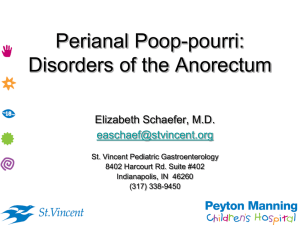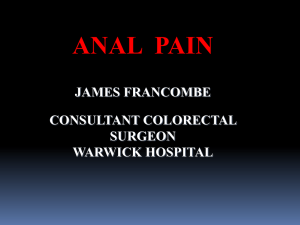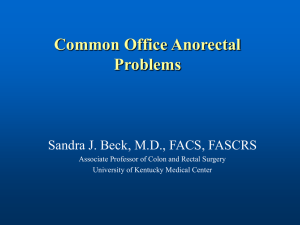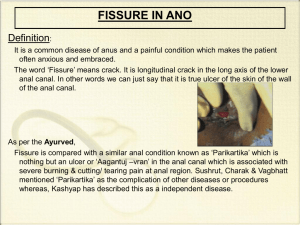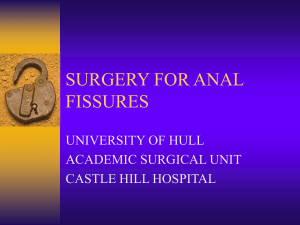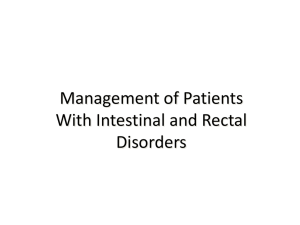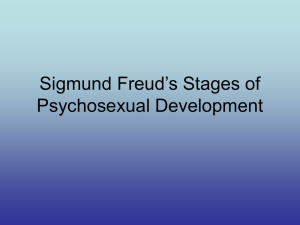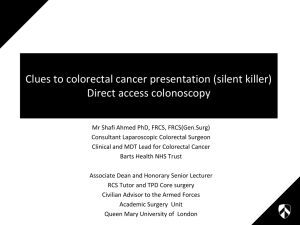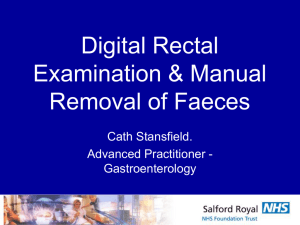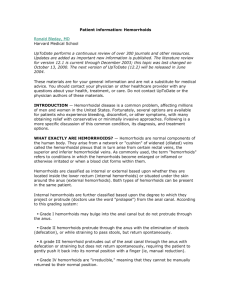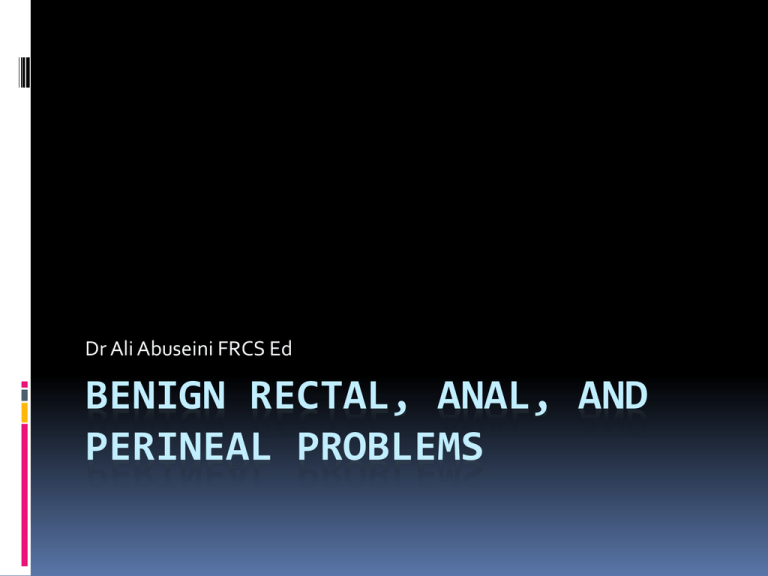
Dr Ali Abuseini FRCS Ed
BENIGN RECTAL, ANAL, AND
PERINEAL PROBLEMS
Benign Rectal, Anal, and Perineal
Problems
Anatomy
Dentate line divides the
rectal mucosa, which is
generally insensitive and is
lined with columnar
mucosa, from the
anoderm, which is highly
sensitive (because of
somatic innervation) and
lined with modified
squamous mucosa.
Benign Rectal, Anal, and Perineal
Problems
Anatomy (continue)
The anal canal is surrounded by two muscles
- Internal sphincter innervated by autonomic
nervous system, maintaining resting anal tone
and under involuntary control
- External sphincter innervated by somatic nerve
fibers, generates the voluntary anal squeeze and
plays the key role in maintaining anal continence
Benign Rectal, Anal, and Perineal
Problems
Anatomy (continue)
The areas surrounding
the anorectum is
divided into four
spaces
- Peri-anal
- Ischioanal
- Supralevator
- Intersphincteric
(intermuscular)
Hemorrhoids
Fibro-muscular cushions that line the anal
canal
Classically found in three locations
- Right anterior
- Right posterior
- Left lateral
- Small secondary cushions may be found
lying between the main cushions
Hemorrhoids
They are part of normal anal anatomy
Play role in normal mechanism of fecal
continence, they get engorged during
straining or performance of Valsalva
maneuver, which completes the occlusion of
the anal canal and prevents stool loss with
none defecatory straining
Hemorrhoids
Broadly classified as
- Internal proximal to
dentate
- External distal to
dentate, redundant
folds of peri-anal skin,
usually asymptomatic
unless thromboses
Hemorrhoids
Hemorrhoids
Internal Hemorrhoids Disease
Manifested by two main symptoms
- Painless Bleeding
- Protrusion
(Pain is rare as they originate above dentate line)
Most popular etiologic theory states that
Hemorrhoids result from chronic straining at
defecation
Continued straining causes engorgement and
bleeding, as well as hemorrhoidal prolapse
Hemorrhoids
Internal Hemorrhoids Disease (continue)
Grades
- Grade 1 Bleeding without prolapse
- Grade 2 prolapse that spontaneously reduce
- Grade 3 prolapse necessitating manual
reduction
- Grade 4 irreducible prolapse
Hemorrhoids
Internal Hemorrhoids Disease
History
- Bleeding
- Protrusion
- Chronic Constipation (extensive bathroom readers)
Physical examination
- Visual inspection may reveal prolapsing hemorrhoidal
tissue appearing as rosette of three distinct pink-purple
hemorrhoidal groups
- If no prolapse, anoscopy reveals redundant anorectal
mucosa proximal to dentate line in the classic locations
Hemorrhoids
Internal Hemorrhoids Disease
Management
Ranges from (depending on hemorrhoid grade)
Reassurance
to
operative hemorrhoidal excision
Hemorrhoids
Internal Hemorrhoids Disease / Management
Therapies classified into three categories
Diet and lifestyle modification
None operative and office procedures
Operative hemorroidectomies
Hemorrhoids
Internal Hemorrhoids Disease / Management
(1)Diet and life style modification
All patients grade 1 or 2 and most patients with grade 3
Correct constipation
High fiber diet
Liberal water intake
Fiber supplement
Sitz bath (soothing effect ability to relax anal sphincter)
Topical creams
Hemorrhoids
Internal Hemorrhoids Disease / Management
(2)None operative and office procedures
If diet and life style modification are not effective
Rubber band ligation
Ligation of hemorrhoid with elastic bands
Successful in 2/3 to 3/4 in patients with grade 1 or 2
- Complications
- Bleeding
- Pain
- Thromboses
- Perianal sepsis (pain, fever, difficult urination)
Hemorrhoids
Hemorrhoids
Internal Hemorrhoids Disease /
Management
(2)None operative and office
procedures
Infrared coagulation applied to
apex of each hemorrhoid at top of
anal canal
Infrared radiation coagulates tissue
protein and evaporates water from
cell
Extent of tissue destruction depends
on intensity and duration of the
application
Not effective in treating large
amount of prolapsing tissue, most
useful for grade 1 and small grade 2
hemorrhoids
hemorrhoids
Internal Hemorrhoids Disease / Management
(2)None operative and office procedures
Sclerotherapy
Less popular nowadays
Injection of sclerosant into anorectal submucosa to
decrease vascularity and increase fibrosis (injection at
apex of hemorrhoids at anorectal ring)
Agents used (phenol in oil, sodium morrhuate, and
quinine urea)
Hemorrhoids
Internal Hemorrhoids Disease / Management
(3) Operative Hemorrhoidectomies
Reduction of blood flow to anorectal ring
Removal of redundant hemorrhoidal tissue
Fixation of redundant mucosa
Procedures
Hemorrhoidectomy
Stapled Hemorrhoidectomy
Hemorrhoids
External Hemorrhoids
Asymptomatic except when secondary thrombosed
Thrombosis may result from defecatory straining or extreme
physical activity or may be random event
Patient presents with constant anal pain of acute onset
Physical examination identifies external thrombosis as purple mass
at anal verge
Management
- Depends on patients symptoms
- In the first 24 – 72 hours after onset, pain increase and excision is
warranted
- After 72 hours, pain generally diminishes
Hemorrhoids
External Hemorrhoids
If operative treatment is chosen,
entire thrombosed hemorrhoid
has to be excised
Incision and drainage of clot
shouldn’t be done as this can
lead to re-thrombosis and
exacerbation of symptoms
Anal Fissure
Tears or splits in the anoderm
just distal to dentate line
Acute or chronic
Acute fissures are caused by
mechanical force generated by
the passage of large bowel
movement through an anal
canal that is too small to
accommodate it safely and
easily (though they can be
caused by diarrhea)
Posterior midline 90% of fissures
in females, and 99% of those in
males
Anal Fissure
Decreased blood flow or increased mechanical stress
may account for the propensity of these fissures to occur
at this location
Repeated injury (hard or watery bowel movement ) may
result in development of chronic fissure
Anal Fissure
Clinical Evaluation
Symptoms
Pain (knife like or tearing sensation)
Bright red rectal bleeding after bowel movement, minor
and seen on toilet paper
Associated with anal spasm that persist for several hours
after each bowel movement
Anal Fissure
Clinical Evaluation
Physical Examination
Difficult , extremely tender anus
Split in anoderm, about 1 cm long, in posterior midline
just distal to dentate line
In chronic fissure
Classic triad - Hypertrophy of anal papilla
- Anal fissure
- Sentinel skin tag
(with exposed internal anal sphincter muscle at base of
fissure)
Anal Fissure
Multiple fissures or fissures
that occur away from
anterior or posterior
midline, should raise
suspicions that other
problems may be present
Anal Fissure
Management
Acute anal fissure
History less than 4 – 6 weeks
None operative
- Fiber supplement
- Stool softeners
- Generous water intake
- Sitz bath
- Local anesthetic ointment
Rapidly alleviate symptoms and bring about complete
healing
Anal Fissure
Management
Chronic anal fissure
Longer than 4 – 6 weeks
Respond less to none-operative measures
Surgical procedure of choice lateral internal anal
sphintrotomy
Cure in 95 -98%
Complications
- Incontinence to flatus 0 – 18%
- Soiling 0 – 7%
- Fecal incontinence 0 – 0.17%
Anal Fissure
Management
Therapeutic alternatives
Topical Nitroglycerin (cause neurogenic relaxation of
internal sphincter(
Nifedipine gel or ointment (reduce local demand for O2
and mechanical contraction of the muscle
Topical Diltiazem
Botulinum Toxins (from clostridium botulinum) eliminate
spasm and contraction of sphincter
Anorectal Abscess
Pathophysiology
Most anorectal abscesses are of cryptogenic
They begin as infections in the anal glands that
surrounds the anal canal and empty in the anal crypts at
the dentate line
The ducts leading to and from glands become obstructed
by feces or traumatized tissue, the secondary infection
develops and follow the path of least resistance
Anorectal Abscess
Clinical Evaluation
Categorized according to space in which they occur Peri-
anal, Ischioanal, Supralevator, Intersphincteric
(intermuscular)
Perianal abscesses are the most common, together with
ischioanal abscesses account for 90% of perianal
infections
Presentation (Pain, fever, chills, malaise, s/t systemic
toxicity)
Anorectal Abscess
Anorectal Abscess
Clinical Evaluation
Examination
Fluctuant, erythematous, tender area in the perineum or
perianal area
In case of supralevater or intersphenteric abscesses,
there may be no external manifestations, however,
digital rectal examination may reveal tender mass above
anal canal
Management
Adequate Drainage
Fistula in Ano
Communication between anal canal and anal skin
Usually begins in a crypt at the dentate line and follows a
course either between the internal and external
sphincters (the most common location) resulting in
ischioanal abscess, or above sphincter leading to
supralevator abscess
After abscess drainage (one of three possibilities)
- Fistula heals spontaneously
OR - Abscess heals to recur in the future
OR - Abscess heals but chronic draining fistula remains
Fistula in Ano
Clinical Evaluation
After drainage of Abscess, fistula is usually associated
with chronic serosanguinous to seropurulent discharge
As long as fistula remains open and draining, patient
report little pain
If fistula close externally, abscess may develop
Physical Examination reveals 2 – 3 mm opening in the
perianal skin, with surrounding induration
Fistula tract can be palpated as firm cord between
external opening and anal canal
Fistula in Ano
Clinical Evaluation
The relation ship between
external opening to internal
opening is suggested by
Googsall’s rule
Fistula In Ano
Clinical Evaluation
Fistulas are classified into four
categories according to their
relation to anal sphincter
- Intersphincteric
- Trans-sphincteric
- Supra-sphincteric
- Extra-sphincteric
Fistula In Ano
Management
Chronic fistulas call for surgical treatment
Unroofing entire fistula tract (fistulotomy) and leaving
wound open to heal secondarily
Fistula that course through significant amount of
sphincter muscle, can’t be opened entirely because
incontinence will result. In this condition the fistula is
partially open with the musculature left intact and
encircled with seton (tight (cutting seton) or un-tight)
OR close internal opening with advancement flap
Pilonidal Sinus Disease
Derived from Latin words pilus (hair) and nidus (nest)
It denotes a chronic subcutaneous infection and foreign body
reaction to hairs imbedded in the skin or to abnormalities of follicles
in the natal cleft
Most common in men between the onset of puberty and 40 years of
age, and in obese persons
Clinical evaluation
- most patient experience an episode of acute abscess formation
- After abscess resolves, sinus tract develops
- Later in most cases sinus tract resolve, however, in the minority
chronic disease or recurrent disease develops
Pilonidal Sinus Disease
Physical examination
One or more small dermal pits at the base of intergluteal
cleft
Tracking from the pits (usually proceeding in a cranial
and lateral direction) appears as areas of induration
If there is abscess, the area will be erythematous, tender
and draining pus may be evident
Pilonidal Sinus Disease
Pilonidal Sinus Disease
Management
Abscess must be drained (incision & drainage)
40% of acute pilonidal abscesses treated with incision and drainage develop into
chronic sinuses
Operations for sinus tract
- Closed techniques (coring out follicles and brushing the tracts), very high
recurrence rate
- Laying open (un-roofing) the tract with healing by granulation, healing time 48
days, recurrence rate 13%
- Wide and deep excision of the sinus alone, healing time 72 days, recurrence rate
13%
- Excision and primary closure, healing time two weeks, recurrence rate 15%
Pilonidal Sinus Disease
Management
None operative conservative approach
- Meticulous hair control (natal cleft shaving)
- improved perineal hygiene
- Limited lateral incision and drainage for treatment of
abscess
Hydradenitis Suppurativa
Chronic recurrent inflammatory process involving the
apocrine glands of the axilla, the groin, and peri-anal
region
Occlusion of follicles and abnormalities of apocrine ducts
are believed to be the causative factors
Disease can result in chronically draining wounds and
sinus tracts and can become quite painful and
debilitating
Hydradenitis Suppurativa
Management
Medical may afford temporary relief of symptoms
Most patients eventually require surgical therapy
Incision and drainage or un-roofing of sinus reserved for
early and acute disease
Local excision provides adequate control of symptoms,
recurrence rate higher than 50%
Wedge excision with secondary granulation
Pruritus Ani
Dermatologic condition of the perianal skin characterized by
uneasiness or itching in the area around anus
Predisposing factors
- Poor peri-anal hygiene (related to incontinence, diarrhea, or
excessive hair)
- Over hygiene
- Excessive moisture
- Irregularities of peri-anal skin (from hemorrhoids, fistulas, or
previous surgery)
- Skin hypersensitivity
- Diet
- Decreased resistance to infection
- Injury to peri-anal skin
Pruritus Ani
Clinical Evaluation
History and physical examination to
suggest possible causes of pruritus
Inspection of peri-anal skin with
gentle retraction of buttocks under
bright lighting
Characteristic finding is
erythematous or thickened skin
which result in whitish appearance
with accentuation of the radial anal
skin creases
Skin may be excoriated or ulcerated
(with thickening process called
Lichenification)
Large excoriations can coalesce
forming weeping ulcers
Pruritus Ani
Clinical Evaluation
Digital rectal examination to assess competence of anal sphincter at
rest and at maximal squeeze
Anoscopy and proctoscopy should be performed
Management
Cause has to be eliminated
Keep peri-anal area dry
Avoid trauma to area
Peri-anal area should be gently washed, never scrubbed
Avoid irritating foods (tomatoes, pepper, citrus fruits and juices,
coffee, colas, beer, milk , nuts and any food stuff found to be
associated with increased gas, indigestion and diarrhea
Maintain regular bowel habbits
Pruritus Ani
Management (continue)
Avoid creams, lotions and emollients
Hydrocortisone cream may be applied for one week
If candidal yeast infection is found, try antifungal lotion,
solution or powder
If standard measures fail to elicit improvement, fungal
and viral cultures and even biopsy may be necessary to
exclude an infectious or neoplastic cause
Solitary Rectal Ulcer
Syndrome
Clinical condition characterized by rectal bleeding,
copious mucous discharge, anorectal pain and difficult
evacuation
SRUS can have single rectal ulcer, multiple ulcers or even
no ulcers
When present, ulcers usually occur on the anterior rectal
wall just above the anorectal ring
Ulcers usually appear as shallow lesions with punched
out gray-white base that is surrounded by hyperemia
Cause unclear, associated with chronic inflammation or
trauma (internal intussception or prolapse of the rectum,
direct digital trauma, or forces to evacuate hard stool)
Solitary Rectal Ulcer
Syndrome
Management
Treatment is directed at alleviating symptoms or
interfering with some of the proposed etiologic
mechanisms
Conservative therapy (e.g. high fiber diet, lifestyle
changes etc) should be tried first
Pharmacologic therapy (e.g. anti-inflammatory enemas
and suppositories), limited success but worth trying
If symptoms persists, localized resection may be
considered
Patients with prolapse, prolapse need to be treated
either with perineal procedures or abdominal procedures
Questions
Which is true regarding anal sphincter function
a. when the rectum is distended, the external sphincter relax and the internal
sphincter contract.
B. when the rectum is distended. The internal sphincter contract and the external
sphincter relax.
C. The External sphincter is responsible for resting anal pressure
D. The internal sphincter is responsible for resting anal pressure.
E. The external sphincter has an autonomic nerve sensation
The most common complication after
hemorroidectomy is which of the following?
A. Urine retention
B. Rectal bleeding
C. Incontinence
D. wound infection
E. Anal stricture.
The fistula in ano traversing the external anal sphincter and
intersphincteric plane is categorized as:
A. Intersphincteric
B. Transsphincteric
C. Suprasphincteric
D. Extrasphincteric
E. Subsphincteric
Which is not true regarding perianal abscess.
A. cryptoglandulr theory explain its pathology
B. clinically presented as severe perianal pain
C. once diagnosed ,the initial treatment is IV antibiotics
D. if it is not treated can be complicated by fistula in ano
E. can be treated by catheter drainage.
Pilonidal Sinus Disease which false
A. the commonest site is natal cleft
B. conservative treatment is effective in some
cases.
C. can be complicated by abscess formation
D. If an abscess is found it should be drain
E. Recurrence rate is very low after surgery

